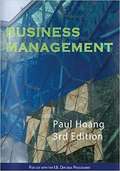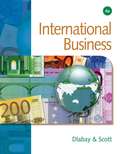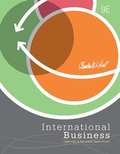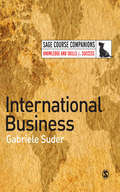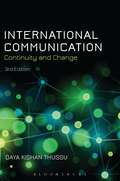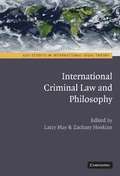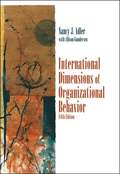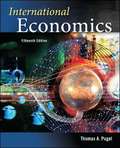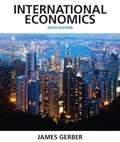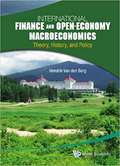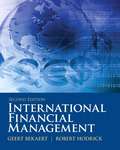- Table View
- List View
Intermediate Second Year Telugu Text Book - Andhra Pradesh Board
by P Vijay Kumar R Sumathi Devi R Chandrasekhar Reddy M Bagaiah Dr T Pramod Kumar Dr K Anand Rao Dr B Sundar Rao Dr N Seshu BabuThis is the prescribed text book for Telugu subject in Andhra Pradesh Board Intermediate Second Year.
Intermediate Second Year Telugu Text Book - Telangana Board
by Acharya Banna IlaiahThis is the prescribed text book for the second year Intermediate Telugu - Second laguage subject for the students of Telangana Board
Intermediate World History A: Student Pages (Semesters 1 & #2)
by K12An edition that provides students worksheets and assessments on world history
Intern to a Monster (Fountas & Pinnell Classroom, Guided Reading)
by Jackie Parker Eoin CoveneyNIMAC-sourced textbook. A DREAM IN DANGER. Rudi's job as junior intern on a movie set is his first step toward the life of his dreams—being a screenwriter himself. But the star of the movie is threatening to stop Rudi's career dead in its tracks—before it even gets started.
International Baccalaureate Business & Management (Second Edition)
by Paul HoangThis book follows the format of the IB Business & Management syllabus (first examination in 2009). It is a dedicated text for both the Standard Level (SL) and Higher Level (HL) courses.
International Baccalaureate Business and Management
by Paul HoangThis book follows the format of the IB Business Management syllabus (first examination in 2016). It is a dedicated text for both the Standard Level (SL) and Higher Level (HL) courses. Units and sections that only apply to HL students are clearly highlighted. The textbook contains 210 examination-style questions. Case studies from around the world have been used in these questions to signify the international nature of IB Business Management. There are 90 examination tips that appear throughout the text. Over 125 Theory of Knowledge questions are integrated in the text. 55 IB Learner Profile connections are also included as part of the IB teaching and learning pedagogy.
International Business
by Mason A. Carpenter Sanjyot P. DunungInternational Business is one of the most challenging and exciting courses to teach in the Business School. To teach a current, dynamic and complete course you need a textbook by authors as passionate and informed about International Business as you are. Carpenter and Dunung's International Business: The Opportunities and Challenges of a Flat World provides exploration into building, leading, and thriving in global organizations in an increasingly flat world. The authors define "Flat world" as one where (1) service industries that dwarf manufacturing industries in terms of scale and scope, (2) an Internet that pervades life and work, and (3) networks define modern businesses, whether service or manufacturing. Carpenter and Dunung's text is designed to speak to technologically-savvy students who see national borders as bridges and not barriers. The authors use the lexicon of international business, and additionally, develop students' knowledge of international contexts with the aim that they may launch, run, and work in any organization that is global in scope (or is wrestling with global competition or other global threats)
International Business
by Mason A. Carpenter Sanjyot P. DunungInternational Business is one of the most challenging and exciting courses to teach in the Business School. To teach a current, dynamic and complete course you need a textbook by authors as passionate and informed about International Business as you are. Carpenter and Dunung's International Business: The Opportunities and Challenges of a Flat World provides exploration into building, leading, and thriving in global organizations in an increasingly flat world. The authors define "Flat world" as one where (1) service industries that dwarf manufacturing industries in terms of scale and scope, (2) an Internet that pervades life and work, and (3) networks define modern businesses, whether service or manufacturing. Carpenter and Dunung's text is designed to speak to technologically-savvy students who see national borders as bridges and not barriers. The authors use the lexicon of international business, and additionally, develop students' knowledge of international contexts with the aim that they may launch, run, and work in any organization that is global in scope (or is wrestling with global competition or other global threats).
International Business (4th Edition)
by Les Dlabay James Calvert ScottInternational Business 4E provides students with the attitudes, knowledge, and skills for entry-level international business and marketing occupations. Content includes political, legal, financial, economic and social/cultural considerations. Students will be able to understand and compare the way in which business and marketing is conducted domestically versus internationally. The text covers real-world applications, projects, technology, ethics, and cross-curricular links. Students will find the communication sections particularly useful in helping them prepare international communication and trade documentation. The technology coverage from a global perspective helps students research and prepare interactive multimedia presentations.
International Business Competing in the Global Marketplace (Ninth Edition)
by Charles W. L. HillMarket-defining since it was introduced, International Business: Competing in the Global Marketplace by Charles W. L. Hill, sets the standard. Hill draws upon his experience to deliver a complete solution-print and digital―for instructors & students by being: Integrated - Progression of Topics Application Rich - Strong on Strategy Current - Thought Provoking Relevant - Actual Practice of International Business
International Business Strategy
by Alain VerbekeHow can you best extend your knowledge of how multinational enterprises (MNEs) function? What does globalization mean for today's managers? How do students turn the message from academic literature into effective business strategies within an MNE? This practical textbook shows how the key concepts from business strategy literature can be applied to multinational enterprise. MBA and Masters students will gain the practical knowledge and skills needed to succeed as effective managers in multinational companies through a critical study of mainstream strategy models and the analysis of forty-five key journal articles. More than twenty 'half-length' case studies from leading firms including Honda, IKEA and Danone show globalization in practice at the firm level. The book also Identifies seven central themes from the literature for successful global strategies and unifies them into a clear framework that can be applied to real businesses worldwide.
International Business: A Role In Corporate Responsibility, Conflict Prevention And Peace (SAGE Course Companions series)
by Dr Gabriele SuderThe Sage Course Companion on International Business is an easy-to-navigate support guide to the International Business curriculum. It will allow readers to extend their understanding of key concepts and enhance their thinking skills in line with course requirements. This book also provides guidance on essential study skills and advice on developing critical thinking about international business.<P><P> Designed to compliment existing textbooks for the course, the Companion provides:<P> - A helpful overview of International Business key concepts and theories in support of your course expectations<P> - Tips, notes and possible exam questions to help you remember key points and International business issues<P> - 'Going further' sections to help you on your way to earning extra marks<P> - Guidance and excercises to aid study and revision skills<P> - Pointers to success in exams and written excercises<P> The Sage Course Companion in International Business is much more than a revision guide; it is an essential tool that will help readers take their course understanding to new levels and help them achieve success in their undergraduate course.
International Communication: A Reader
by Daya Kishan ThussuThis comprehensive Reader brings together seminal texts in media and communication from both traditional as well as more recent scholarship. <p><p> Readings are drawn from an international range of scholars and organized to reflect the growing internationalization of the field, with clearly defined sections covering key aspects of global communication. In addition to the core academic readings, key policy documents are also included to demonstrate the development of the political, economic and technological infrastructure that underpins the global system of media and communication.
International Communication: Continuity and Change
by Daya Kishan ThussuThe third edition of International Communication examines the profound changes that have taken place, and are continuing to take place at an astonishing speed, in international media and communication. Building on the success of previous editions, this book maps out the expansion of media and telecommunications corporations within the macro-economic context of liberalisation, deregulation and privitisation. It then goes on to explore the impact of such growth on audiences in different cultural contexts and from regional, national and international perspectives. Each chapter contains engaging case studies which exemplify the main concepts and arguments.
International Criminal Law and Philosophy
by Larry May Zachary HoskinsInternational Criminal Law and Philosophy is the first anthology to bring together legal and philosophical theorists to examine the normative and conceptual foundations of international criminal law. In particular, through these essays the international group of authors addresses questions of state sovereignty; of groups, rather than individuals, as perpetrators and victims of international crimes; of international criminal law and the promotion of human rights and social justice; and of what comes after international criminal prosecutions, namely, punishment and reconciliation. International criminal law is still an emerging field, and as it continues to develop, the elucidation of clear, consistent theoretical groundings for its practices will be crucial. The questions raised and issues addressed by the essays in this volume will aid in this important endeavor.
International Dimensions Of Organizational Behavior (Fifth Edition)
by Nancy J. Adler Allison GundersenThe world of organizations is no longer defined by national boundaries. INTERNATIONAL DIMENSIONS OF ORGANIZATIONAL BEHAVIOR breaks down the conceptual, theoretical, and practical boundaries limiting our ability to understand and work with people in countries and cultures around the world. Adler's hallmark approach views global complexity as neither unpredictable nor random; rather, she demonstrates that variations across cultures and their impacts on organizations follow systematic, predictable patterns. The authors' blend of substance and readability--including a wealth of research and examples from around the world--results in a text that is authoritative and richly detailed.
International Economics
by Robert J. CarbaughDiscover why Carbaugh's best-selling INTERNATIONAL ECONOMICS, 18E is a favorite among students of all backgrounds for its clear, concise presentation of international trade and finance theory. This edition uses the latest examples from around the world as well as updated, practical applications to vividly demonstrate the relevance of the theory you are learning. You see how the concepts you are mastering apply to today's economic issues and global policy questions as you examine the economic impact of events such as Brexit, China's forced technology transfer, China's Belt Road initiative, the U.S.-Mexico-Canada agreement and the global pandemic. Written and visually driven discussions make content understandable even if you have little economics background. This edition is organized around five themes that emphasize global economics and trade issues. This streamlined presentation is clear, concise and contemporary with award-winning author Dr. Carbaugh.
International Economics (Fifteenth Edition)
by Thomas PugelInternational Economics, 15e continues to combine rigorous economic analysis with attention to the issues of economic policy that are alive and important today in this field. Written in a concise and readable format, Pugel uses economic terminology when enhancing the analysis so that the reader can build their understanding of global economic developments and evaluate proposals for changes in economic policies. The text is informed by current events and includes the latest in applied international research, all the time avoiding jargon for jargon's sake. Like earlier editions, Pugel also places international economics events within a historical framework. The overall treatment continues to be intuitive rather than mathematical and is strongly oriented towards policy.
International Economics (Sixth Edition)
by James GerberA principles-level introduction to international economics that is accessible to all majors. This book is also suitable for readers interested in the field of international economics. <p><p> International Economics uses a rich array of case studies to illuminate economic institutions and policies as well as recent developments in the global economy—without readers having to rely on a prerequisite knowledge of higher-level math. Further, the book’s flexible approach—with self-contained chapters and comprehensive coverage—allows instructors to adapt the text easily to a wide range of syllabi.<p> The sixth edition preserves the organization and coverage of the fifth edition and adds a number of updates and enhancements. All tables and graphs have been updated and every chapter begins with a list of student learning outcomes. Chapter 13, The United States in the World Economy, is heavily revised and refocused towards U.S. international economic relations, including NAFTA, but adds material on other trade agreements, including a new case study on preferential agreements such as the African Growth and Opportunity Act.
International Economics: Theory And Policy (Tenth Edition)
by Maurice Obstfeld Marc Melitz Paul R. KrugmanInternational Economics: Theory and Policy provides engaging, balanced coverage of the key concepts and practical applications of the two main topic areas of the discipline. For both international trade and international finance, an intuitive introduction to theory is followed by detailed coverage of policy applications. With this new tenth edition, the author team of Nobel Prize-winning economist Paul Krugman, renowned researcher Maurice Obstfeld, and Marc Melitz of Harvard University continues to set the standard for International Economics courses. <p><p> This program provides a better teaching and learning experience-for you and your students. It will help you to: * Personalize learning with MyEconLab: This online homework, tutorial, and assessment program fosters learning and provides tools that help instructors to keep students on track. * Reveal theory and applications of trade and finance via a unified structure: Balanced coverage of theory and applications aids student retention and highlights the relevance of course material. * Give students learning tools to master course material: Numerous in-text learning resources engage students and encourage further exploration of course topics. * Provide the most updated coverage: Thoroughly updated content ensures that students are up to date on key economics issues.
International Economics: Theory and Policy
by Steve SuranovicInternational Economics: Theory and Policy is built on Steve Suranovic’s belief that students need to learn the theory and models to understand how economics works and how economists understand the world. And, that these ideas are accessible to most students if they are explained thoroughly. So, if you are looking for an International Economics text that will prepare your PhD students while promoting serious comprehension for the non-economics major, Steve Suranovic’s International Economics: Theory and Policy is for you. International Economics: Theory and Policy presents numerous models in some detail; not by employing advanced mathematics, but rather by walking students through a detailed description of how a model’s assumptions influence its conclusions. Then, students learn how the models connect with the real world. Steve’s book covers positive economics to help answer the normative questions; for example, what should a country do about trade policy, or about exchange rate policy? The results from models give students insights that help us answer these questions. Thus, this text strives to explain why each model is interesting by connecting its results to some aspect of a current policy issue. This text eliminates some needlessly difficult material while adding and elaborating on other principles. For example, the development of the relative supply/demand structure, or the presentation of offer curves, are omitted as to not go too deeply into topics that tend to confuse many students at this level. Steve developed new approaches in this text including a simple way to present the Jones’ magnification effects, a systematic method to teach the theory of the second best, and a unique description of valid reasons to worry about trade deficits. These new approaches help students learn the concepts and models and derive conclusions from them. If you like to take a comprehensive look at trade policies, be sure to check out the chapter on Trade Policy (7). It provides a comprehensive look at many more trade policies than are found in many of the printed textbooks on the market today. International Economics: Theory and Policy by Steve Suranovic is intended for use in a full semester trade course, a full semester finance course, or a one semester trade/finance course.
International Finance and Open-Economy Macroeconomics: Theory, History, and Policy
by Hendrik Van Den BergThis historically-based textbook on international finance and open-economy macroeconomics provides a complete course on the theory and policies that shaped our international financial system. Utilizing the 1944 Bretton Woods Conference as a unifying theme, the book covers all the standard topics of international finance, such as foreign exchange markets, balance of payments accounting, macroeconomic policy in an open economy, exchange rate crises, multinational enterprises, international banking, and the evolution of our international financial system. The detailed international financial theory is presented in a lively manner that reflects the close relationship between actual world events and the development of economic thought.The book also analyzes the causes of the 2008 international financial crisis and recession, encourages critical thinking about whether the current international financial system promotes human well-being, and concludes with a discussion on whether it is time to summon the world's financial leaders to another Bretton Woods Conference. In additional to providing students with a solid understanding of international finance and open-economy macroeconomics, the book is written in a reader-friendly style that makes it a good reference for anyone interested in the many fascinating issues related to our still-evolving global financial system and, more generally, our global economy.
International Finance: Theory and Policy
by Steve SuranovicInternational Finance Theory and Policy is built on Steve Suranovic's belief that to understand the international economy, students need to learn how economic models are applied to real world problems. It is true what they say, that "economists do it with models." That's because economic models provide insights about the world that are simply not obtainable solely by discussion of the issues. International Finance Theory and Policy develops a unified model of the international macroeconomy. The text provides detailed descriptions of major macroeconomic variables, covers the interest rate parity and purchasing power parity theories of exchange rate determination, takes an exhaustive look at the pros and cons of trade imbalances and presents the well-known AA-DD model to explore the effects of fiscal and monetary policy under both fixed and flexible exchange rates. The models are developed, not by employing advanced mathematics, but rather by walking students through a detailed description of how a model's assumptions influence its conclusions. But more importantly, each model and theory is connected to real world policy issues. The Finance Text has the following unique features: o Begins with an historical overview of the international macroeconomy to provide context for the theory. o Concludes with a detailed discussion of the pros and cons of fixed and floating exchange rate systems. o Provides an extensive look at the issue of trade imbalances. Readers learn techniques to evaluate whether a country's trade deficit (or surplus) is dangerous, beneficial, or benign. o Explains how purchasing power parity is used to make cross country income comparisons. o Offers clear detailed explanations of the AA-DD model. o Applies the AA-DD model to understand the effects of monetary and fiscal policy on GDP, the exchange rate, and the trade balance.
International Financial Management
by Geert Bekaert Robert HodrickAn approach that blends theory and practice with real-world data analysis. International Financial Management seamlesslyblends theory with the analysis of data, examples, and practical case situations. Overall, Bekaert/Hodrick equips future business leaders with the analytical tools they need to understand the issues, make sound international financial decisions, and manage the risks that businesses may face in today's competitive global environment. All data in this edition has been updated to reflect the most recent information, including coverage on the latest research, global financial crisis, and emerging markets.
International Financial Management
by Jeff MaduraPrepare for success in international finance with this best-selling book's effective presentation of in-depth theory and practical applications. INTERNATIONAL FINANCIAL MANAGEMENT 12E builds on the fundamental principles of corporate finance to provide the timely information and contemporary insights needed to prosper in today's global business environment. This book discusses a wide range of managerial topics using a strong corporate perspective and highlights financial reform and its impact on the international finance today. An emphasis on the most recent financial industry trends further prepares readers to understand and effectively manage within the dynamic field of international finance.

